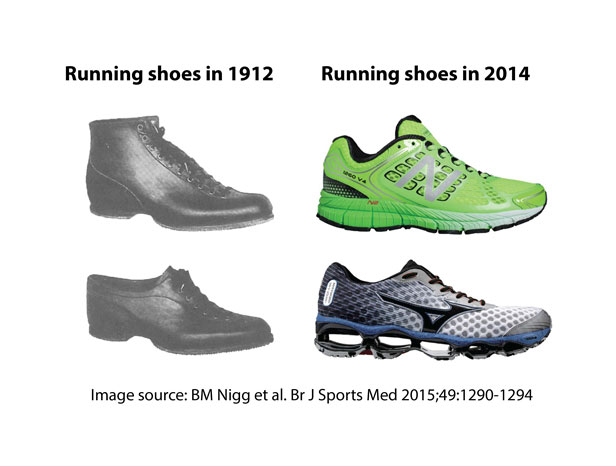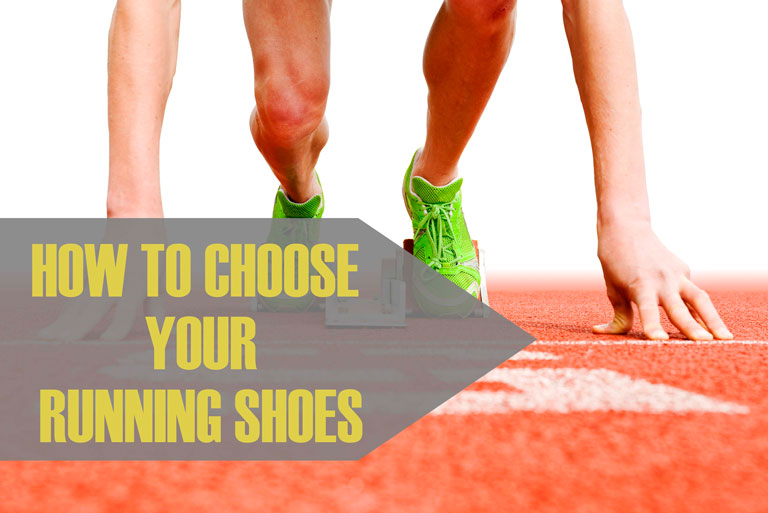If you have read my previous article on running injury prevention, you probably have thought to yourself, what about footwear? She didn’t talk about running shoes at all!
It seems counterintuitive, but apparently, the type of shoes you wear is not one of the top predictors for running-related injuries… as far as we know. A big part of the problem is that nobody had specifically studied the effect of running shoes on running injuries until 2012! (1) I know, I couldn’t believe it, either.
This is not to say that good shoes are unnecessary, but we might consider redefining what a pair of “good running shoes” is.
What Do We Know About Running Shoes
-
Shoe type does NOT predict running injuries as much as we thought
Below is a comparison of running shoes from 1912 (left) and modern running shoes in 2014 (right). A century ago, the running shoes are equivalent to dress shoes today. As the footwear changes over the years, running injury rates haven’t seemed to change in the last 40 years. (1)

-
The way you run will be different with different shoes
- Barefoot/ un-cushioned minimalist shoes: You will tend to land more flat-footed or on the ball of your foot, and your steps becomes a bit shorter but faster. (2-4) Some researchers support this type of running biomechanics, and believe it’s the more natural running pattern, while others find it greatly increases the likelihood of injuries. (5-8)
- Standard running shoes: 94% of the people wearing standard running shoes use rear-foot-strikes, basically pounding the pavement with heel-to-toe strikes. (4)
-
The effects of shoes on your bone and muscle
- Barefoot/ un-cushioned minimalist shoes: When landing with the front part of your foot, the muscle in the front of your leg (tibialis anterior) is less activated and the calf muscles (medial and lateral gastrocnemius) are more activated. (8-10) Contrary to popular belief, this type of running seems to increase stress to foot bones and increase pain at the shin and calf. (6, 11,12)
- Standard running shoes: The muscle in front of your leg (tibialis anterior) is activated more with standard running shoes. (10)
-
No epidemiological evidence shows foot pronation to be related to running injuries.
Traditionally, we are taught that foot pronation increases injuries. Many people have shoe inserts or orthotics to prevent such pronation. It turns out that there has been no epidemiological evidence to support the belief that foot pronation increases injuries. (1) In fact, one study in 2014 with a large sample size showed that pronators had a significantly lower number of injuries/1000km of running than neutrals. (13) At what point does pronation become a risk factor? We don’t really know at the moment. What we do know is that pronation between 7 and 10° seems to be the safest way to run. (13)
How To Choose A Pair Of Good Running Shoes
- There is no consensus on a specific type of running shoes that can reduce injuries. (3,5)
- Choose shoes that feel comfortable to YOU. I know this almost sounds too simple, but what you have read about how certain running shoes can reduce injury is largely unsupported by the scientific evidence. Different people select different shoes as the most comfortable. Some people like arch support, and others don’t. Although comfort is a subjective matter, studies show that shoes that are more comfortable are associated with fewer injuries. (1)
- Shock absorbent insoles can reduce tibial stress injuries, although we don’t know what the exact percentage of shock absorption we need is. (14)
- By switching running techniques between rear-foot strikes and fore-foot strikes, you can potentially off-load injury prone tissues. (10)
- If you want to improve running economy, consider running with lighter shoes. More specifically, a pair of shoes that weigh no more than 440g (roughly 1 lb). (15)
- If you want to transition from standard running shoes to minimalist shoes, you must do it slowly and cautiously to avoid potential stress injury in the foot. (9,11)
- Replace your running shoes every 300 miles. (14)
References:
- Nigg BM, Baltich J, Hoerzer S, Enders H. Running shoes and running injuries: mythbusting and a proposal for two new paradigms: ‘preferred movement path’ and ‘comfort filter’. Br J Sports Med. 2015;49:1290-1294. [British Journal of Sports Medicine]
- Olin ED, Gutierrez GM. EMG and tibial shock upon the first attempt at barefoot running. Hum Mov Sci. 2013 Apr;32(2):343-52. [PubMed]
- Perkins KP, Hanney WJ, Rothschild CE. The risks and benefits of running barefoot or in minimalist shoes: a systematic review. Sports Health. 2014 Nov;6(6):475-80. [PubMed]
- Hollander K, Argubi-Wollesen A, Reer R, Zech A. Comparison of minimalist footwear strategies for stimulating barefoot running: a randomized crossover study. PLoS One. 2015;10(5):e0125880. [PubMed]
- Lorenz DS, Pontillo M. Is there evidence to support a forefoot strike pattern in barefoot runners? A review. Sports Health. 2012 Nov;4(6):480-4. [PubMed]
- Ryan M, Elashi M, Newsham-West R, Taunton J. Examining injury risk and pain perception in runners using minimalist footwear. Br J Sports Med. 2014;48:1257-1262. [British Journal of Sports Medicine]
- Kaplan Y. Barefoot versus shoe running: from the past to the present. Phys Sportsmed. 2014 Feb;42(1):30-5. [PubMed]
- Yong JR, Slider A, Delp SL. Differences in muscle activity between natural forefoot and rearfoot strike during running. J Biomech. 2014 Nove 28;47(15):3593-7. [PubMed]
- Olin ED, Gutierrez GM. EMG and tibial shock upon the first attempt at barefoot running. Hum Mov Sci. 2013 Apr;32(2):343-52. [PubMed]
- Landreneau LL, Watts K, Heitzman JE, Childers WL. Lower limb muscle activity during forefoot and rearfoot strike running techniques. Int J Sports Phys Ther. 2014 Dec;9(7):888-897. [PunMed]
- Ridge ST, Johnson AW, Mitchell UH, Hunter I, Robinson E, Rich BS, Brown SD. Foot bone marrow edema after a 10-wk transition to minimalist running shoes. Med Sci Sports Exerc. 2013 Jul;45(7):1363-8. [PubMed]
- Shih Y, Lin KL, Shiang TY. Is the foot striking pattern more important than barefoot or shod conditions in running? Gait Posture. 2013 Jul;38(3):490-4. [PubMed]
- Nielsen RO et al. Foot pronation is not associated with increased injury risk in novice runners wearing a neutral shoe: a 1-year prospective cohort study. Br J Sports Med. 2014;48:440-447. [British Journal of Sports Medicine]
- Craig DI. Medial tibial stress yndrome: evidence-based prevention. J Athl Train. 2008 May-Jun;43(3):316-318. [PubMed]
- Fuller JT, Bellenger CR, Thewlis D, Tsiros MD, Buckley JD. The effect of footwear on running performance and running economy in distance runners. Sports Med. 2015 Mar;45(3):411-22. [PubMed]
About the Author
Dr. Lily Semrow is a Board Certified Chiropractic Neurologist who focuses on Neuro-Structural Correction. She has a B.S. in Nutrition and a doctorate in Chiropractic. She has a passion for serving families and helping people who could not get better through traditional and alternative means.

